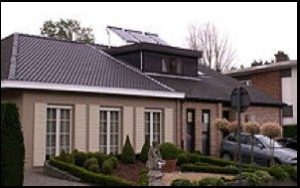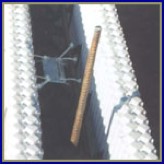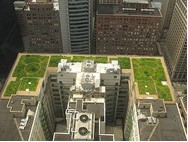
The prospect of building Green is a relatively new in practice in the United States, as most products are disposable after a relatively short life. This carries over to the construction of residences, as well commercial buildings, as the need of an individual occupant is typically short-term. Homeowners typically stay in a home on an average of seven years and the nature of retail is terribly cyclical. Most owners believe that any benefit beyond the one they are going to enjoy is not a good investment of their dollar. In some cases, certain organizations do not move as often and will have a long-life cycle with a particular building; this is very much true with public school systems, universities and municipalities. These entities are looking for a long-term life span from their buildings, in addition to providing a safe environment for the occupants of these structures.
There are many initiatives currently on the books backed by tax benefits for the private user to consider when making construction decisions based on the best use of their dollar, as well as the environment ~ the proverbial win-win. Some of the evolving changes seen in the construction industry in relation to green building are:
Solar Water Heating: Solar water heating is based on thermodynamics – direct heating of liquids by the sun where no electricity is directly generated; the amount of heat generated depends on the amount of heat delivered by the sun at a particular place. This heated water can be used for a variety of uses such as heating swimming pools; providing for an under-floor heating system; and for space heating and cooling. In many climates, the use of a solar hot water system can provide up to 85% of the domestic hot water energy needed. In some cases, these systems use electricity for pumping fluids from the reservoir tank in the heating system, as well as to offer a reliable and constant supply of hot water; this should be considered when installing a system. The installation process also needs to include a plan for efficient insulation of the water pipes connecting the collector and the storage tank. Sometimes controllers are used to regulate the timing of operation, especially in an active system. When considering a solar water heating system, it is more beneficial to install a larger system than a smaller one because the price is not linearly proportional. It is better to use a system that covers nearly all of the domestic hot water needs, as this will make for a more rapid cost recovery on the system.
Sprayed Polyurethane Insulation – Sprayed foam insulation has become very prominent in the building industry. This process is being used for indoor and outdoor thermal insulating of roofs, walls and floors. A study by Bayer MaterialScience, LLC suggests that the energy saved over the life of a building through the use of polyurethane insulation can yield a 70 to 1 return on the energy required to produce the product itself. For more information visit http://www.bayer.com/en/covestro.aspx

Insulated Concrete Form – [ICF]: Insulated concrete form or solid poured construction techniques add safety and energy efficiency. This is an excellent way to kill two birds with one stone. The nature of a solid poured concrete structure as compared to one made with wood (Southern Yellow Pine) returns to the land of the three little pigs and a wolf. The concrete in the exterior walls of these structures provide up to R90 insulation with the added bonus of 5000 PSI concrete as an exterior wall. These concrete homes are generational homes; a person can expect to sell their home after many years of use or will it to their children and provide more than a liability. Generational homes have been the norm in Europe as their construction has always relied on solid wall block on block construction.
Energy Efficient (HVAC) – Since the mid 1970’s manufacturers of HVAC equipment have been making an effort to make the systems they manufacture more efficient. This was originally driven by rising energy costs and has more recently been driven by increased awareness of environmental issues; the Energy Star program was created in 1992 by the Environmental Protection Agency in an attempt to reduce energy consumption and greenhouse gas emission. Initiated as a voluntary labeling program designed to identify and promote energy efficient products, Energy Star began with labels for computer products. In 1995, the program was significantly expanded, introducing labels for residential heating and cooling systems and new homes. As of 2006, more than 40,000 Energy Star products were available in a wide range of items including major appliances, office equipment, lighting, home electronics, and more. In addition, the label can also be found on commercial and industrial buildings. In 2006, about 12 percent of new housing in the United States was labeled Energy Star. The EPA estimates that it saved about $14 billion in energy costs in 2006 alone. [www.energystar.gov]

Green Roofs – This is really interesting and a totally terrifying prospect from the point of a general contractor. We have been taught that dwell time on a roof is its biggest enemy and have always attempted to remove water from a roof as quickly as possible. This technique is designed to plant landscaping on a roof reducing its thermal and carbon signature. The plants make for a green space where previously there would have been just more impervious surface and additional storm water runoff to contend with. Now we have a lush, green benefit top side and a roof under the plants roots and soil. The benefits are obvious and I expect that the technology is there; we will have to wait and see about the installation.
The National Association of Home Builders [NAHB] along with other organizations are striving to promote green building; the NAHB will be hosting a convention on green building later this spring. Green building is continuing to be supported by the US Environmental Protection Agency; please visit http://www.epa.gov/greenbuilding/ for more information.
Complete General Contractors, Inc. specializes in hurricane damage restoration from residential, commercial, industrial and by municipality. John Minor has worked post-hurricane sites since Opal in 1995; his experience is far reaching – from the Carolina’s to Texas and all along the coast of Florida. The staff of Complete can meet with you to review your preparedness plan, and we will be there afterwards should you ever need us. We specialize in the actual restoration, prevention, as well as, dispute resolution of a claim. Call the company the pros choose – call Complete.
This information should not be substituted for professional legal advice; consult with your lawyer for legal advice and ask your insurance professional to discuss the details of your policy and insurance needs.